Air con MITSUBISHI ASX 2018 Owner's Manual (in English)
[x] Cancel search | Manufacturer: MITSUBISHI, Model Year: 2018, Model line: ASX, Model: MITSUBISHI ASX 2018Pages: 514, PDF Size: 34.89 MB
Page 2 of 514

ForewordE09200107208
Thank you for selecting an ASX as your new vehicle.
This owner’s manual will add to your understanding and full enjoyment of
the many fine features of this vehicle.
It contains information prepared to acquaint you with the proper way to oper-
ate and maintain your vehicle for the utmost in driving pleasure.
MITSUBISHI MOTORS Europe B.V. reserves the right to make changes in
design and specifications and/or to make additions to or improvements in
this product without obligation to install them on products previously manu- factured.
It is an absolute requirement for the driver to strictly observe all laws and
regulations concerning vehicles.
This owner’s manual has been written in compliance with such laws and reg- ulations, but some of the contents may become contradictory with later amendment of the laws and regulations.
Please leave this owner’s manual in this vehicle at time of resale. The next
owner will appreciate having access to the information contained in this
owner’s manual.
Repairs to your vehicle:
Vehicles in the warranty period:
All warranty repairs must be carried out by a MITSUBISHI MOTORS Au-
thorized Service Point.
Vehicles outside the warranty period:
Where the vehicle is repaired is at the discretion of the owner.Throughout this owner’s manual the words WARNING and CAUTION
appear.
These serve as reminders to be especially careful. Failure to follow instruc-
tions could result in personal injury or damage to your vehicle.WARNING
Indicates a strong possibility of severe personal injury or death if in-
structions are not followed.
CAUTION
Means hazards or unsafe practices that could cause minor personal in-
jury or damage to your vehicle.
NOTE
Gives helpful information.
You will see another important symbol:
*: indicates optional equipment.
It may differ according to the sales classification; refer to the sales cata- logue.
Abbreviations used in this owner’s manual:
LHD: Left-Hand DriveM/T: Manual TransmissionRHD: Right-Hand DriveA/T: Automatic Transmission CVT: Continuously Variable Transmission
The symbol used on the vehicles:
: See owner’s manual
Information for station service
E09300104660
Fuel
CapacityPetrol-powered vehicles2WD models58 litres*1
63 litres *24WD models60 litresDiesel-powered vehicles 60 litres
Recommended
fuel
Petrol-powered vehicles Unleaded petrol octane number (EN228)1600 models, 1800 models: 95 RON or higher
2000 models: 90 RON or higher
Diesel-powered vehicles Cetane number (EN590): 51 or higher
Refer to the “General information” section for the fuel selection.Engine oilRefer to the “Maintenance” section for the selection of engine oil.Tyre inflation pressureRefer to the “Maintenance” section for the tyre inflation pressure.*1 : For vehicles with vehicle identification numbers that begin with “4”
*2 : For vehicles with vehicle identification numbers that begin with “J”CAUTIONl Diesel-powered vehicles are designed to use only diesel fuel that meets the EN 590 standard.
Use of any other type of diesel fuel can adversely affect the engine.NOTEl For the location of the vehicle identification number, refer to “Vehicle identification number” on page 11-02.
© 2017 Mitsubishi Motors Corporation18
OGAE18E1
BLO-17-000482
Page 4 of 514

Instruments and controlsE001001091491. Combination headlamps and dipper switch p. 5-50Turn-signal lever p. 5-57
Front fog lamp switch* p. 5-58
Rear fog lamp switch p. 5-58
2. Instruments p. 5-02
3. Shift paddles* p. 6-36
4. Windscreen wiper and washer switch p. 5-59 Rear window wiper and washer switch p. 5-63
Headlamp washer switch* p. 5-64
5. Engine switch* p. 3-13
6. Cruise control switch* p. 6-54
7. Ignition switch* p. 6-12
8. Supplemental restraint system (SRS) - driver’s knee airbag* p. 4-29
9. Supplemental restraint system (SRS) - airbag (for driver’s seat) p. 4-24, 4-29
Horn switch p. 5-65
10. Tilt & Telescopic steering lever p. 6-08
11. Bluetooth® 2.0 interface* p. 7-46
12. Steering wheel audio remote control switches* p. 7-23
13. Sonar switch* p. 6-79
14. Lane Departure Warning (LDW)* p. 6-68
15. FCM ON/OFF switch* p. 6-63
16. Headlamp levelling switch* p. 5-55
Instruments and controls
1-02OGAE18E1Overview1
Page 5 of 514
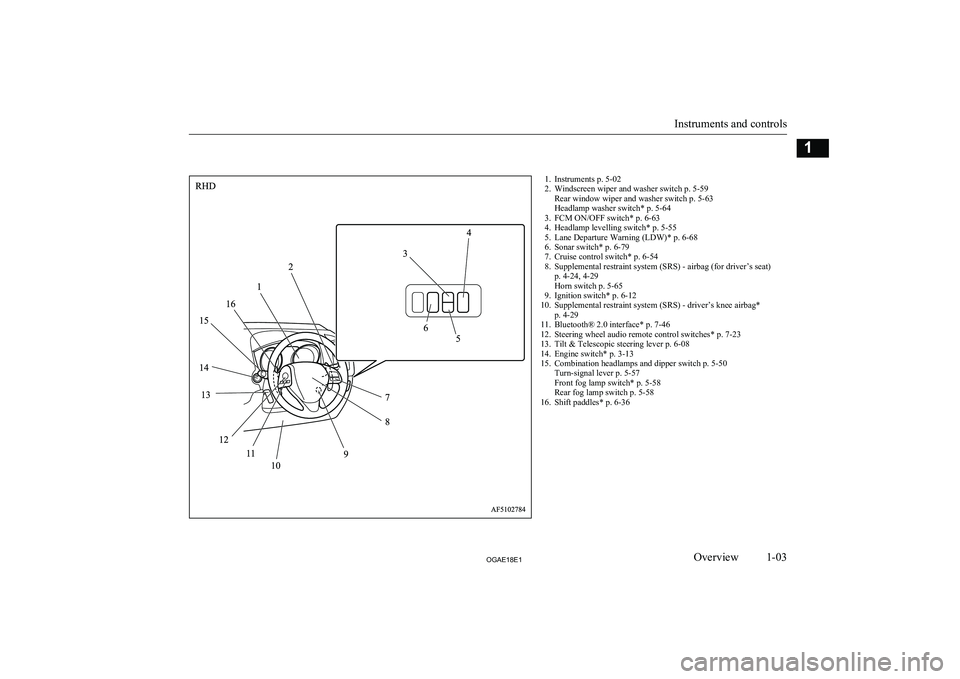
1. Instruments p. 5-02
2. Windscreen wiper and washer switch p. 5-59 Rear window wiper and washer switch p. 5-63
Headlamp washer switch* p. 5-64
3. FCM ON/OFF switch* p. 6-63
4. Headlamp levelling switch* p. 5-55
5. Lane Departure Warning (LDW)* p. 6-68
6. Sonar switch* p. 6-79
7. Cruise control switch* p. 6-54
8. Supplemental restraint system (SRS) - airbag (for driver’s seat) p. 4-24, 4-29
Horn switch p. 5-65
9. Ignition switch* p. 6-12
10. Supplemental restraint system (SRS) - driver’s knee airbag* p. 4-29
11. Bluetooth® 2.0 interface* p. 7-46
12. Steering wheel audio remote control switches* p. 7-23
13. Tilt & Telescopic steering lever p. 6-08
14. Engine switch* p. 3-13
15. Combination headlamps and dipper switch p. 5-50 Turn-signal lever p. 5-57
Front fog lamp switch* p. 5-58
Rear fog lamp switch p. 5-58
16. Shift paddles* p. 6-36
Instruments and controls
1-03OGAE18E1Overview1
Page 6 of 514

1. Audio system* p. 7-11MITSUBISHI Multi-Communication System*
DISPLAY AUDIO*
Smartphone Link Display Audio*
Refer to the separate owner’s manual
2. Centre ventilators p. 7-02
3. Key slot* p. 3-20
4. Side ventilators p. 7-02
5. Front passenger’s airbag ON-OFF switch p. 4-27 Glove box p. 7-76
6. Hazard warning flasher switch p. 5-57
7. Rear window demister switch p. 5-64
8. Drive mode selector* p. 6-39
9. Gearshift or selector lever p. 6-23, 6-26, 6-33
10. Parking brake lever p. 6-06
11. Cup holder p. 7-79
12. Ashtray* p. 7-71
13. Fuel tank filler door release lever p. 2-03
14. Bonnet release lever p. 10-03
15. Fuse box p. 10-19
16. Accessory Socket* p. 7-72 Cigarette lighter* p. 7-71
17. Auto Stop & Go (AS&G) OFF switch* p. 6-19
18. Heated seat switch* p. 4-06
19. USB input terminal* p. 7-67
20. Active stability control (ASC) OFF switch* p. 5-04
21. Multi-information meter switch p. 5-04
22. Air conditioning* p. 7-03
Instruments and controls
1-04OGAE18E1Overview1
Page 7 of 514

1. Audio system* p. 7-11MITSUBISHI Multi-Communication System*
DISPLAY AUDIO*
Smartphone Link Display Audio*
Refer to the separate owner’s manual
2. Multi-information meter switch p. 5-04
3. USB input terminal* p. 7-67
4. Active stability control (ASC) OFF switch* p. 5-04
5. Accessory Socket p. 7-72
6. Auto Stop & Go (AS&G) OFF switch* p. 6-19
7. Heated seat switch* p. 4-06
8. Bonnet release lever p. 10-03
9. Fuel tank filler door release lever p. 2-03
10. Rear window demister switch p. 5-64
11. Air conditioning* p. 7-03
12. Drive mode selector* p. 6-39
13. Parking brake lever p. 6-06
14. Cup holder p. 7-79
15. Ashtray* p. 7-71
16. Gearshift or selector lever p. 6-23, 6-26, 6-33
17. Hazard warning flasher switch p. 5-57
18. Front passenger’s airbag ON-OFF switch p. 4-27 Glove box p. 7-76
19. Fuse box p. 10-19
20. Side ventilators p. 7-02
21. Key slot* p. 3-20
22. Centre ventilators p. 7-02
Instruments and controls
1-05OGAE18E1Overview1
Page 8 of 514
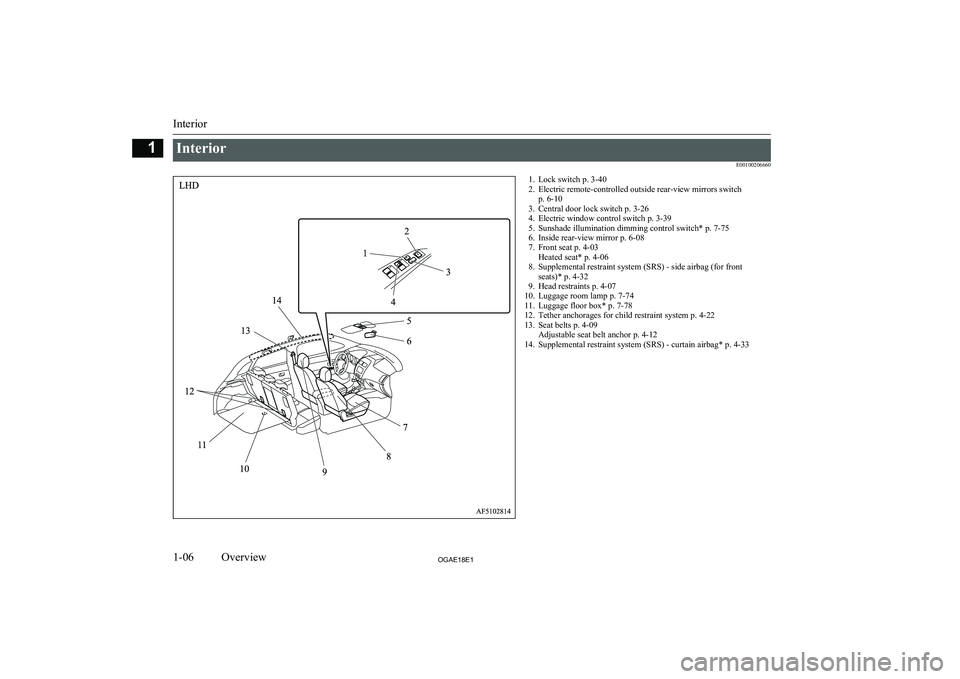
InteriorE001002066601. Lock switch p. 3-402. Electric remote-controlled outside rear-view mirrors switch p. 6-10
3. Central door lock switch p. 3-26
4. Electric window control switch p. 3-39
5. Sunshade illumination dimming control switch* p. 7-75
6. Inside rear-view mirror p. 6-08
7. Front seat p. 4-03 Heated seat* p. 4-06
8. Supplemental restraint system (SRS) - side airbag (for front seats)* p. 4-32
9. Head restraints p. 4-07
10. Luggage room lamp p. 7-74
11. Luggage floor box* p. 7-78
12. Tether anchorages for child restraint system p. 4-22
13. Seat belts p. 4-09 Adjustable seat belt anchor p. 4-12
14. Supplemental restraint system (SRS) - curtain airbag* p. 4-33
Interior
1-06OGAE18E1Overview1
Page 10 of 514
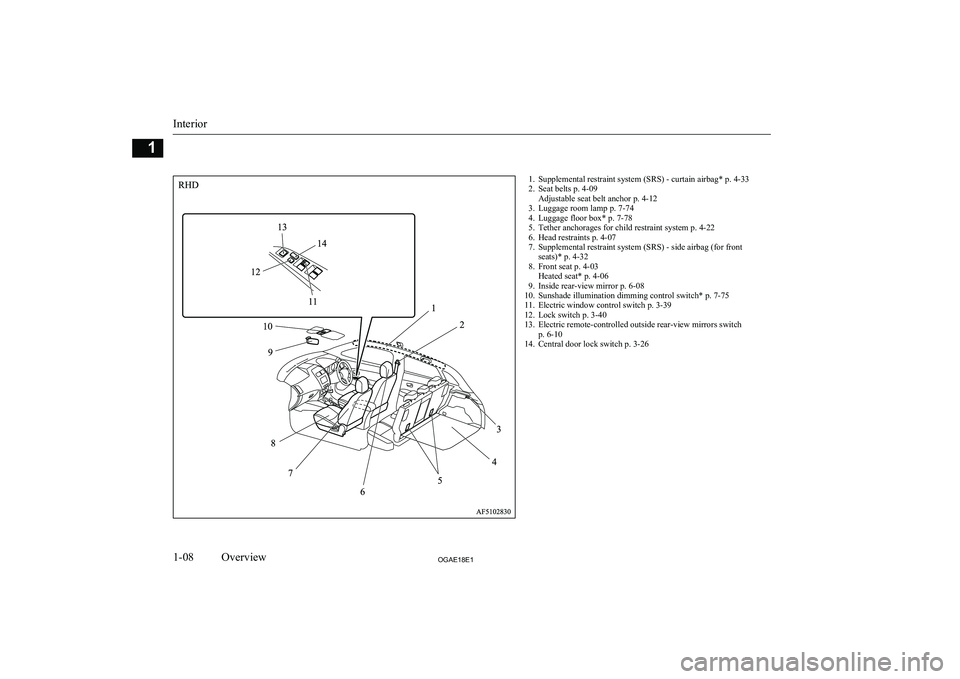
1. Supplemental restraint system (SRS) - curtain airbag* p. 4-33
2. Seat belts p. 4-09 Adjustable seat belt anchor p. 4-12
3. Luggage room lamp p. 7-74
4. Luggage floor box* p. 7-78
5. Tether anchorages for child restraint system p. 4-22
6. Head restraints p. 4-07
7. Supplemental restraint system (SRS) - side airbag (for front seats)* p. 4-32
8. Front seat p. 4-03 Heated seat* p. 4-06
9. Inside rear-view mirror p. 6-08
10. Sunshade illumination dimming control switch* p. 7-75
11. Electric window control switch p. 3-39
12. Lock switch p. 3-40
13. Electric remote-controlled outside rear-view mirrors switch p. 6-10
14. Central door lock switch p. 3-26
Interior
1-08OGAE18E1Overview1
Page 24 of 514
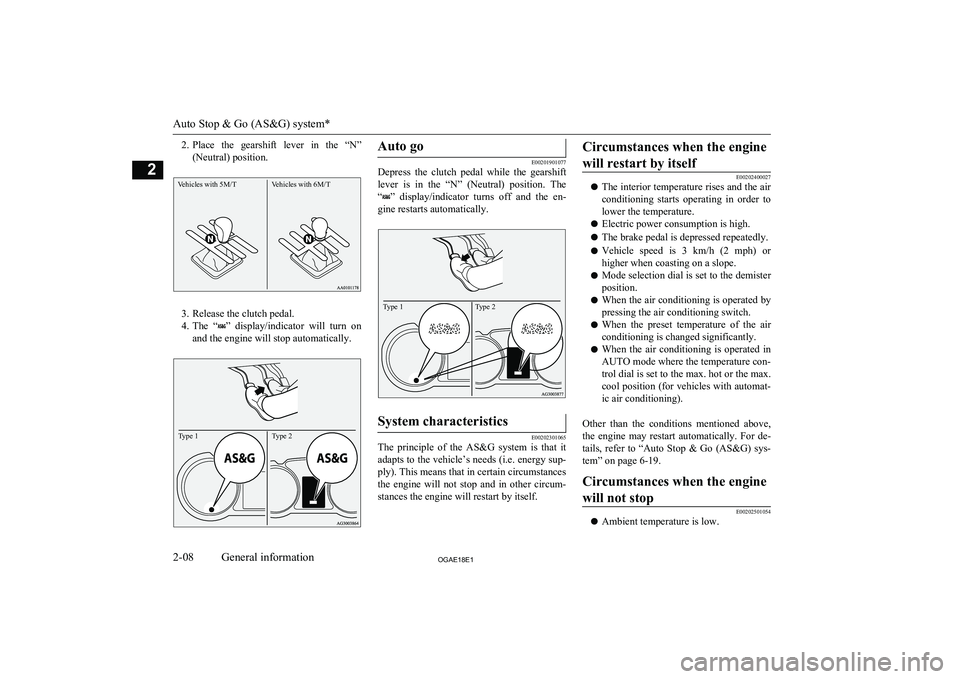
2.Place the gearshift lever in the “N”
(Neutral) position.Vehicles with 5M/TVehicles with 6M/T
3. Release the clutch pedal.
4. The “
” display/indicator will turn on
and the engine will stop automatically.
Type 1Type 2Auto go
E00201901077
Depress the clutch pedal while the gearshift
lever is in the “N” (Neutral) position. The
“
” display/indicator turns off and the en-
gine restarts automatically.
Type 2Type 1System characteristics
E00202301065
The principle of the AS&G system is that it
adapts to the vehicle’s needs (i.e. energy sup- ply). This means that in certain circumstancesthe engine will not stop and in other circum-
stances the engine will restart by itself.
Circumstances when the engine
will restart by itself
E00202400027
l The interior temperature rises and the air
conditioning starts operating in order to lower the temperature.
l Electric power consumption is high.
l The brake pedal is depressed repeatedly.
l Vehicle speed is 3 km/h (2 mph)
or
higher when coasting on a slope.
l Mode selection dial is set to the demister
position.
l When the air conditioning is operated by
pressing the air conditioning switch.
l When the preset temperature of the air
conditioning is changed significantly.
l When the air conditioning is operated in
AUTO mode where the temperature con-trol dial is set to the max. hot or the max.
cool position (for vehicles with automat- ic air conditioning).
Other than the conditions mentioned above, the engine may restart automatically. For de-
tails, refer to “Auto Stop & Go (AS&G) sys- tem” on page 6-19.
Circumstances when the engine
will not stop
E00202501054
l Ambient temperature is low.
Auto Stop & Go (AS&G) system*
2-08OGAE18E1General information2
Page 25 of 514

lAfter the engine restarts automatically
and the vehicle stops again within 10 seconds.
l After the engine restarts automatically
and the vehicle remains stationary.
l Mode selection dial is set to the demister
position (see illustration below).
l When the air conditioning is operated in
AUTO mode where the temperature con-
trol dial is set to the max. hot or the max.
cool position (for vehicles with automat- ic air conditioning).
Other than the conditions mentioned above, the engine may not stop automatically. For details, refer to “Auto Stop & Go (AS&G)
system” on page 6-19.
Auto Stop & Go (AS&G) system*
2-09OGAE18E1General information2
Page 34 of 514
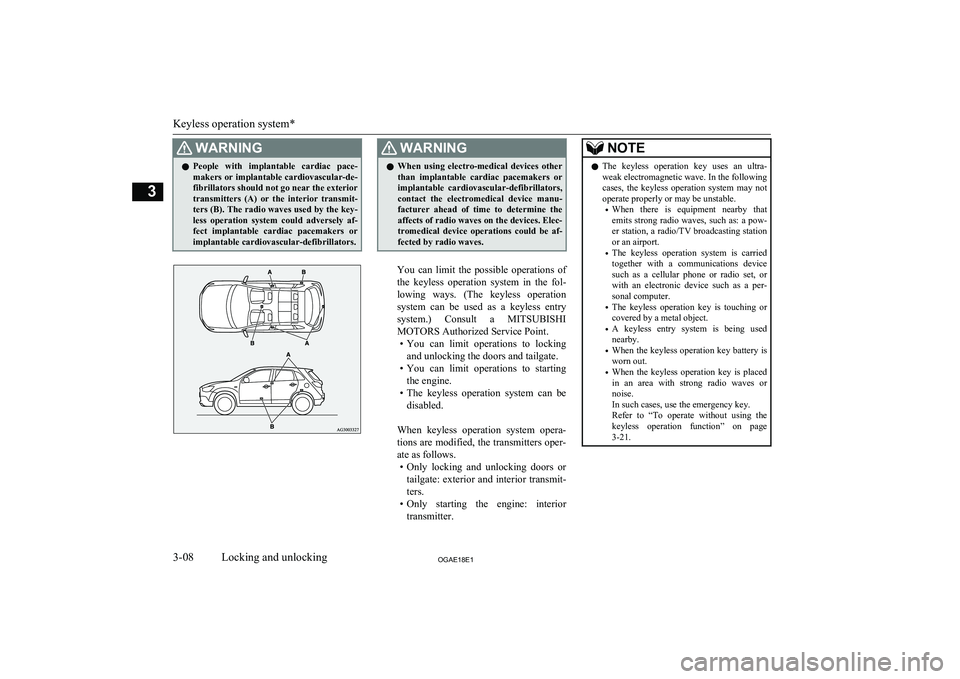
WARNINGlPeople with implantable cardiac pace-
makers or implantable cardiovascular-de- fibrillators should not go near the exterior
transmitters (A) or the interior transmit-
ters (B). The radio waves used by the key-
less operation system could adversely af- fect implantable cardiac pacemakers orimplantable cardiovascular-defibrillators.WARNINGl When using electro-medical devices other
than implantable cardiac pacemakers or implantable cardiovascular-defibrillators,
contact the electromedical device manu- facturer ahead of time to determine theaffects of radio waves on the devices. Elec-
tromedical device operations could be af- fected by radio waves.
You can limit the possible operations of
the keyless operation system in the fol-
lowing ways. (The keyless operation system can be used as a keyless entry system.) Consult a MITSUBISHI
MOTORS Authorized Service Point. • You can limit operations to locking
and unlocking the doors and tailgate.
• You can limit operations to starting
the engine.
• The keyless operation system can be
disabled.
When keyless operation system opera-
tions are modified, the transmitters oper- ate as follows. • Only locking and unlocking doors or
tailgate: exterior and interior transmit- ters.
• Only starting the engine: interior
transmitter.
NOTEl The keyless operation key uses an ultra-
weak electromagnetic wave. In the following
cases, the keyless operation system may not
operate properly or may be unstable.
• When there is equipment nearby that
emits strong radio waves, such as: a pow-
er station, a radio/TV broadcasting station or an airport.
• The keyless operation system is carried
together with a communications device such as a cellular phone or radio set, or
with an electronic device such as a per- sonal computer.
• The keyless operation key is touching or
covered by a metal object.
• A keyless entry system is being used
nearby.
• When the keyless operation key battery is
worn out.
• When the keyless operation key is placed
in an area with strong radio waves or noise.
In such cases, use the emergency key.
Refer to “To operate without using the
keyless operation function” on page 3-21.
Keyless operation system*
3-08OGAE18E1Locking and unlocking3